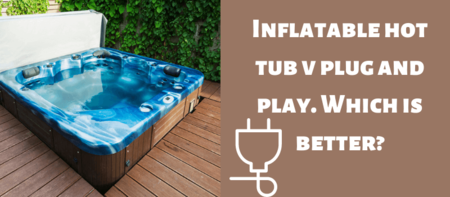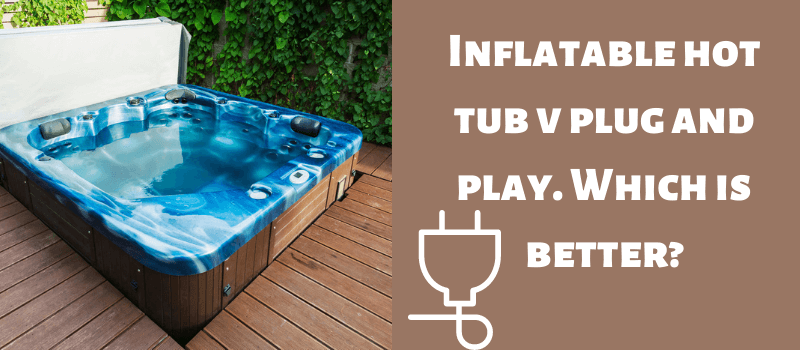
If you are considering buying a hot tub you may well be looking at both inflatable and plug and play models. Both are considerably cheaper than a full, permanent hot tub but which is the best option? Both plug and play and inflatable hot tubs are, to a certain extent, portable and can be set up instantly but there are some major differences between the two. Read on to find out which is the best option for you.
So, inflatable hot tubs v plug and play. Which is better? Inflatable and plug and play hot tubs have their own pros and cons, so determining which one works best for your needs is very much a matter of personal choice. Both offer the advantage of being easy to set up without any need for an electrician or plumber but there are other significant differences between the two that need to be borne in mind.
While plug and play tubs offer more features, they are more costly. Meanwhile, inflatable hot tubs offer the convenience of being easy to store and move around but they don’t last as long and can more easily be damaged. It’s important to know the similarities and differences between both types of model so that you can make a well-informed decision about which one is worth the investment for your home.
| Hot Tub Feature | Inflatable Hot Tub | Plug and Play Hot Tub |
| Low Price | Yes | More than the inflatable but much less than a standard hot tub |
| Portability | Yes | Yes, but less easily than an inflatable |
| Seats | No | Yes |
| Lights | No | Possibly depending on model |
| Speakers | No | Possibly depending on model |
| Jets | Usually bubbles blown by air only | Can have proper water jets |
| Use in Winter | No | Yes |
| Durability | Limited lifespan | Good durability |
| Easy storage? | Yes | Yes, but takes up more room than an inflatable |
| Full size equipment? | No | No |
| Energy efficiency | Poor | Not great |
| Run pump and heater together? | No | No |
| Size | Variable | Variable but generally larger and more generous than an inflatable |
Why Buy An Inflatable Hot Tub?
Inflatable hot tubs are a relatively new addition to the spa marketplace, but they have become surprisingly popular over the past few years. This is down to their two primary advantages – their low price tag and their excellent portability. These spas are supplied in a small box and also often come with their own carrying bag so it can easily be stored away when not in use or taken out and about.
If you’ve always wanted a hot tub that you could take camping with you, an inflatable model is sure to tick all your boxes. Even better, inflatable hot tubs are lightweight so you can easily move them around. This means that, if you want to move your spa indoors on a cold day you can do this without any difficulties.
The primary advantage of an inflatable hot tub is how easy it is to install. When compared with a standard hot tub, setting up your inflatable spa is an absolute breeze. Simply inflate it with the integrated air blower, plug it into your household power supply, fill it up with water and then allow it to heat up ready for use. It couldn’t be simpler. You won’t need an electrician or plumber to get your tub set up – even a complete novice will have no difficulties.
You can even buy them and have them delivered straight from Amazon here.
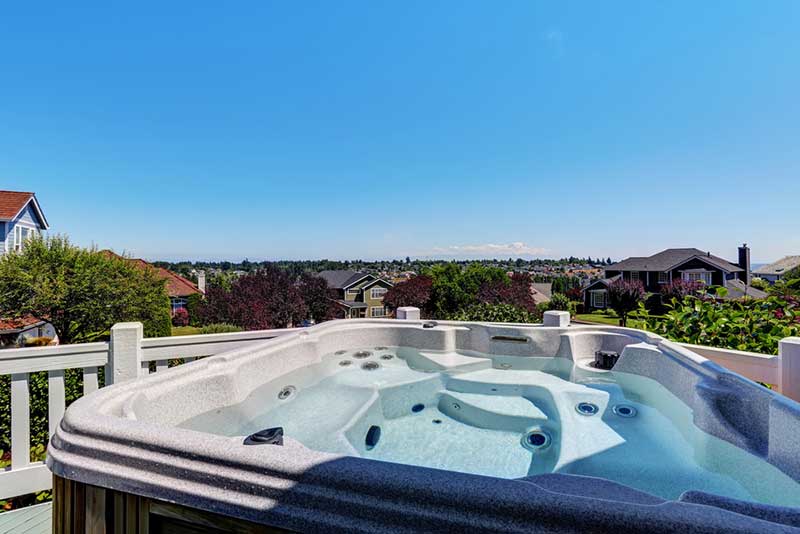
Although inflatable hot tubs aren’t as strong or robust as a standard tub, they are made of a material which is designed to be resistant to punctures and scrapes. While it won’t last forever, it’ll give you a few years of good use before it requires replacement.
Also, since the price of an inflatable spa is much lower than that of a standard hot tub or even a plug and play model you can enjoy good value for money – inflatable spas have brought hot tub bathing within easy reach of people who always wanted to enjoy their own spa experience but thought it was beyond their budget.
On the downside, though, there are some negative points to consider if you’re wondering whether to buy an inflatable hot tub. While their low price tag is very appealing, the trade-off is that they aren’t as durable as other types of spa. This means that, if you aren’t careful, you could end up unwittingly damaging your tub. For example, if you place your hot tub on an uneven or sharp surface, you could puncture it by accident.
Also, although inflatable spas are designed to be portable, it’s important to remember that you cannot move it around when it is full of water. You will need to empty it before moving it to another location. Not only that, but you have to take care which surface you choose to place your spa on. It must be sufficiently strong to support its weight – placing a full hot tub on high decking without reinforcements could be a disaster.
These spas aren’t designed to be used in cold conditions either. With a minimal usable temperature of 40 degrees Fahrenheit inflatable spas simply aren’t suitable for outdoor use during the winter months. This means that you can only really get around 6 months of use from them unless you put it indoors or inside an outbuilding such as a garage.
While inflatable hot tubs are a budget-friendly alternative to a fitted spa, they aren’t as comfortable or as well-equipped. For a start, there aren’t any inbuilt seats, so you have to sit on the floor of the tub. There are also no other inbuilt features such as drink trays, headrests, or in-tub lighting. Most of these can be purchased separately, but they make the price of the tub mount up and they may not be as good as already inbuilt features.
Why Buy A Plug And Play Hot Tub?
Plug and play hot tubs are similar to inflatable tubs in that they don’t need a plumber or electrician to install them in your home. All you need to do is plug them into a household power supply and fill them up using your regular garden hose. They are also more affordable than standard hot tubs so you can enjoy a high-quality spa experience without breaking the bank.
Plug and play spas also come with some excellent features. They have inbuilt seats so bathers can enjoy complete comfort in a way that they cannot with an inflatable hot tub. Also, some models come with high-end features such as LED lights, speakers and water jets for an even more luxurious and fun bathing experience. This makes them a more appealing choice than an inflatable hot tub for those who value comfort.
As an added advantage, plug and play tubs can be used all year round, unlike inflatable models. Since they’re designed to be used in all temperatures, including those below 40 degrees Fahrenheit, they’re a perfect choice for anyone who wants to make the most of their winter bathing.
Since the acrylic material that plug and play spas are made from is robust and strong, this is another benefit. They are low maintenance and will last for longer than an inflatable tub. Not only that, but they are arguably more attractive than inflatable tubs and can be more of an appealing feature in your back garden.
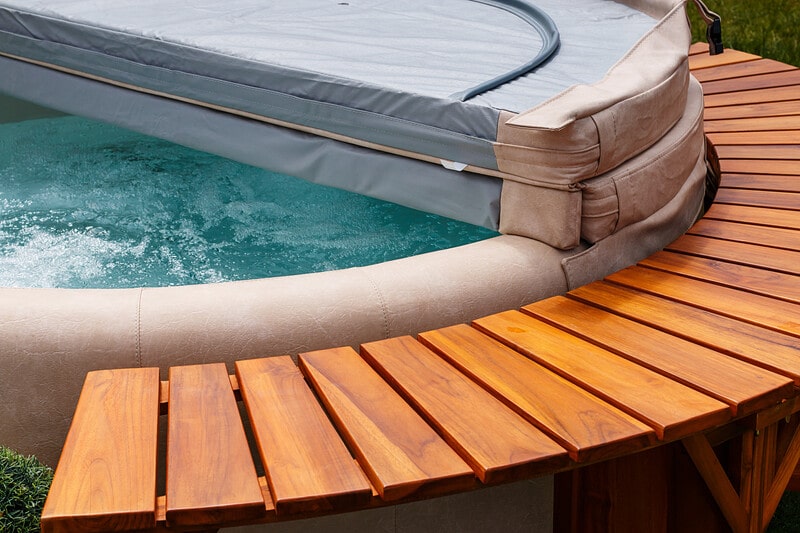
There are, however, some significant differences between plug and play and inflatable hot tubs that could make you reconsider purchasing one.
For a start, plug and play tubs aren’t inflatable. Instead, they are made from acrylic and while they are portable, these spas weigh more and this means they can’t be used for camping or taking out and about with you in the same way as inflatable tubs can.
They come in one piece and so can’t be easily packed away and stored in the same way as an inflatable spa. Their delivery box is heavier, larger and more costly in terms of shipping. Also, if it needs to be transported after purchase you’ll need to use a trailer or van since these models can’t be folded up into a box or bag and put into a car.
Another downside to consider is the added expense of purchasing one of these tubs. Although they’re cheaper than standard hot tubs, they’re still more costly than inflatable models, coming in at around double the price. For anyone on a very tight budget, they may just prove to be unaffordable.
Which Problems Affect Both Plug And Play And Inflatable Hot Tubs?
When comparing plug and play and inflatable hot tubs, it’s important to remember that there are some drawbacks that affect both types of model. These make both less appealing than a standard fitted hot tub for some users.
The first drawback that affects both types of model is the undersized equipment that they use. A main drawback associated with both inflatable and plug and play tubs is their inability to draw sufficient power to run a full-size heater and jet pump. To be able to run from a regular household power outlet, these tubs can have only a 1kW heater and 1HP pump. These are around quarter of the size of those found in a 220 V fitted hot tub.
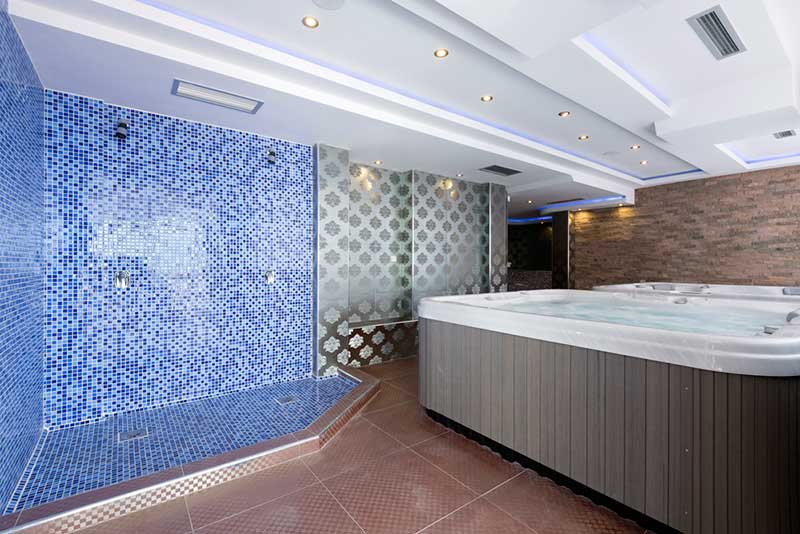
This undersized equipment means that it isn’t possible to support the same number of jets as a standard hot tub could. Also, the jets that these portable models do have are usually less powerful and smaller than those found in a regular hot tub. Add to that the fact that a smaller heater must work harder to heat the water properly and this means it has to run for a longer period of time than a regular hot tub heater. Of course, this, in turn, drastically increases the cost of running your hot tub in the long-run.
The biggest ongoing expense when it comes to running any type of hot tub is heating it. The greater the length of time your hot tub needs to heat, the bigger the energy bill will be when the month comes to an end. To maintain the correct water temperature, especially on colder days, the heater of a plug and play or inflatable hot tub must run virtually all day long and this will dramatically increase the cost of energy required to power it.
Therefore, while these portable models of hot tub are cheaper to buy upfront, they have a higher running cost in the long run. This is something to bear in mind if you’re planning to use your hot tub on a very frequent basis throughout the year.
One further downside to choosing an inflatable or plug and play hot tub is that it will be unable to draw sufficient power to run both its pump at a high speed and the water heater simultaneously. When the pump moves to high speed from low speed, the heater will automatically switch off.
Although this usually won’t be a problem when the weather is warm outside, during the colder months the hot tub will lose several degrees in just one hour if you don’t have the water heater running, and this will make your hot tub less a hot tub and more a warm tub!
Even if you don’t plan to use the jets on high speed, you’ll still find that plug and play and inflatable hot tubs lose some heat over time during use. This is due to the fact that the water heater won’t be capable of keeping up with the loss of heat that occurs whenever the hot tub cover has been removed.
With this in mind, you may be wondering whether it’s worth your while purchasing a plug and play or inflatable hot tub at all, or whether you should save up and invest in a standard model that can be installed permanently in your home or garden.
The answer, of course, will depend on your use of the tub. If you only wish to use it in warmer weather, you’ll find a portable model will work fine for your purposes. However, if you’re planning to use your spa extensively during the winter months you may wish to consider a permanently fitted model.
Inflatable spas cannot be used outdoors in temperatures of under 40 degrees Fahrenheit, and even though plug and play hot tubs can be used outdoors during the winter, the undersized heater means that it may not be good value to go for this portable option. It will cost you more to run an undersized heater when the weather is cold and you’ll find that the heat from the water dissipates more quickly leading to a rather underwhelming and disappointing spa experience.
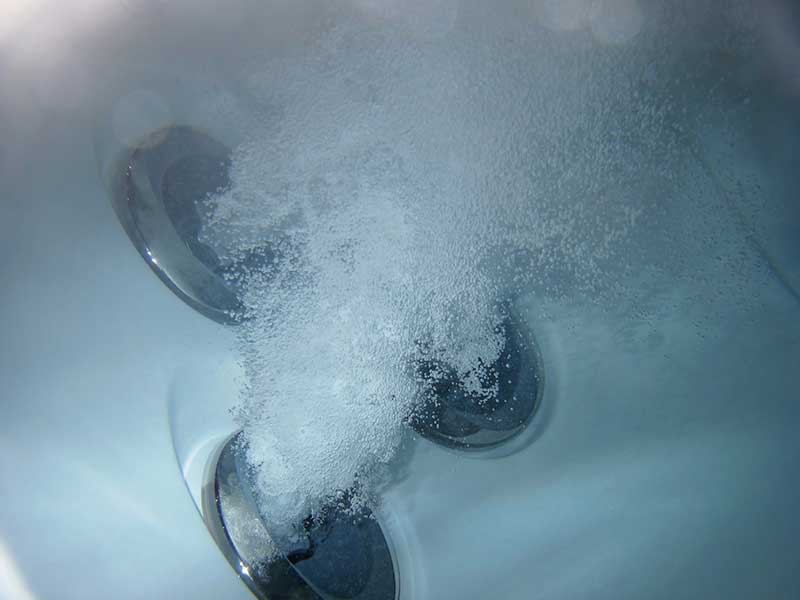
Another time when you may find it a better option to go for an inflatable or plug and play hot tub is when your home lacks the available power for supporting a standard type of hot tub. The majority of fitted hot tubs need a dedicated power service of 40 – 60 in order to function properly. If your electrical panel lacks sufficient available space, purchasing an inflatable or plug and play tub will help you to avoid a costly panel upgrade while still allowing you to enjoy a spa at home.
What Do I Need To Bear In Mind When Choosing Between An Inflatable And A Plug And Play Tub?
Before you make a final decision about whether you want an inflatable or plug and play hot tub there are a number of things to bear in mind that will help you make your choice.
Here are a few of the most important to consider:
Seating – is it important for you to have inbuilt seating in your hot tub or are you happy to sit on the floor or buy separate seating to fit into your inflatable model? If you really want to have inbuilt seating, a plug and play model is the best choice for you.
The number of bathers – usually, you’ll find that inflatable hot tubs are smaller than plug and play models. This is fine if there’s only a couple of bathers, but if you’re planning to squeeze more people into the tub you may need to reconsider. Due to the design of inflatable spas you may find that even just four bathers in a tub may be too intimate unless you’re all very close friends!
Plug and play tubs, meanwhile, tend to be more spacious. There are also models available that can hold 6 or more bathers and these may be a better choice for anyone who wants a more spacious and luxurious experience.
Lighting – do you want to have integrated LED lighting in your hot tub? Then you may want to consider a plug and play tub. Most models will come with underwater lighting already fitted whereas you will almost certainly have to purchase separate lighting for an inflatable tub. Plug and play tubs may even have lighting that as filters to allow for colour changes.
Additional features – as well as lighting and integrated seats, plug and play hot tubs are more likely to come with a host of extra features included in the price. For example, they may have waterfalls so that you can enjoy the gentle sound of running water even if you’re not using the water jets. These kinds of features are either unavailable in inflatable hot tubs or must be purchased separately and fitted after purchase.
Jet options – the amount of jets that come included with your chosen model will determine the kind of experience you can enjoy. It goes without saying that more jets will lead to more bubbles and, therefore, a more relaxing experience.
It’s important to note that most inflatable spas only feature air jets and not water jets. This affects the experience you can expect to enjoy. There are some models that have water jets, but again, they will be few in number and won’t be as powerful as you may hope.
Plug and play spas come with different types of jets and usually have both air and water jets. They may also have adjustable jets for a more personalised spa experience, something which usually isn’t possible with inflatable tubs.
Portability – although plug and play spas are technically portable, they aren’t portable in the same sense as inflatable tubs. An inflatable hot tub can be collapsed completely, packed away into a bag or box and taken anywhere for use.
Plug and play tubs, on the other hand, will not fold flat and cannot fit into a box or bag. Since they come in one piece they must be transported on a large vehicle such as a trailer or van. This is a lot less convenient than an inflatable tub if flexibility and portability are your top concerns.
Storage – when considering portability, you may wish to consider storage too. Since inflatable tubs can be fully collapsed when not in use, they can easily be stored away in a garage, shed or attic until they’re ready for use once more. Plug and play tubs, meanwhile, cannot be easily stored away and so aren’t a space-saving option. This is a consideration if you have a small home or garden.

Durability – how durable do you need your hot tub to be? Although plug and play hot tubs aren’t as robust as a standard permanently fitted spa, they are certainly more durable than inflatable models due to the material that they are made from. They can’t be accidentally scraped or punctured and this means that they’ll last longer than an inflatable model.
Price – if you’re in a very tight budget, you may find that even a plug and play model is out of your price bracket. Inflatable models can be purchased very cheaply and, therefore, this makes them an ideal choice for anyone who wants to save money but still enjoy bubbling water in the comfort of their own home.
Winter use – you cannot really use an inflatable hot tub during the winter months due to the fact that they are unsuitable for use in temperatures of under 40 degrees Fahrenheit. This means that you will need to pack away your spa and store it during the colder weather unless you have a garage or outbuilding in which to use it.
Plug and play hot tubs can be used at any time of the year since the cold weather will not cause any damage to their structure. On the other hand, though, the water may not be as warm as you’d like during the colder months of the year and this is a consideration to keep in mind.
Style – do appearances matter? If so, you may prefer a plug and play hot tub rather than an inflatable one. Although inflatable models represent good value for money and are ideal for temporary use, they aren’t the most stylish option out there. Plug and play tubs have much more attractive designs and would be a better choice for anyone who values the appearance of their tub.
As you can see, there are many things to bear in mind when choosing between inflatable and plug and play hot tubs, but by considering them all carefully you should be able to make a well-informed decision about which is right for your needs and preferences.
Related Questions
How do I care for an inflatable hot tub? Even though inflatable hot tubs aren’t permanently installed, they still need to be cared for properly to keep them in good condition and safe for use.
Inflatable tubs come with a very small filter which can clog easily and which will therefore require more frequent cleaning. You should remove the filter weekly in order to fully clean it. Wipe any debris away using a paper towel than hold the filter beneath running water to keep it in good condition.
You will also still have to regularly test the alkalinity and pH balance of your tub water by using test strips before using the appropriate chemicals to sanitize the water so that you can stay healthy while using it. You should also drain your tub every 3 or 4 weeks according to the manufacturer’s instruction.
When the spa is empty, clean its insides with water, mild liquid soap and a sponge. Rinse it out thoroughly using a hose until you can see no more soap bubbles then allow it to completely dry before you fold it and store it away to prevent mildew and mold developing.
What wattage will a plug and play hot tub draw? It’s important to be aware that plug and play spas don’t draw the same amount of power as a regular spa. In fact plug and play hot tubs will have a water heater that typically draws between 500 and 1500 watts.
As you can imagine, this is a lot lower than the amount that will usually be drawn by bigger hardwired hot tub models. As a result, this means you can either run a two speed jet pump on high but with the water heater switched off, or, alternatively, on a low speed setting with the water heater switched on.
This won’t usually be an issue during the summer months, but if you plan to use your spa in cold weather this could be a problem since the water may not be warm enough if the heater is switched off but the water may not be bubbly enough with the jet speed on low.
Also, due to this reduced power draw, your heart will run on a lower wattage and so the water will take considerably longer to heat up than a standard fitted hot tub.

